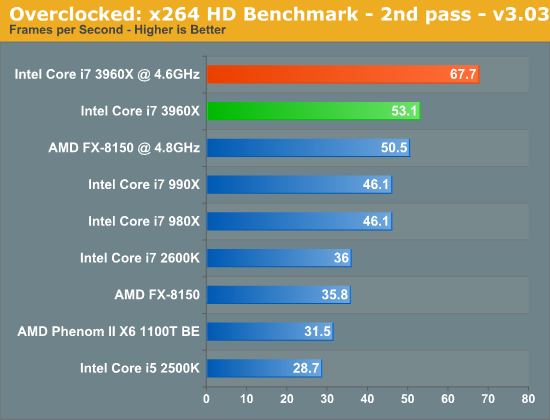Intel Core i7 3960X (Sandy Bridge E) Review: Keeping the High End Alive
by Anand Lal Shimpi on November 14, 2011 3:01 AM EST- Posted in
- CPUs
- Intel
- Core i7
- Sandy Bridge
- Sandy Bridge E
Overclocked Performance
I mentioned earlier that I hit 4.6GHz on my 3960X sample, if you're curious about just how fast that makes the system have a look at this:

The 3960X at 4.6GHz is almost twice as fast as the Core i7 2600K! The added performance does come at the expense of power consumption:

Under load our overclocked testbed consumes 52% more power than a stock 3960X.










163 Comments
View All Comments
SonicIce - Monday, November 14, 2011 - link
cool good review.wharris1 - Monday, November 14, 2011 - link
It would be interested to test the OC'd SBE vs an OC'd SB; I suspect that the 2x advantage of the SBE would fall back in line to around the ~30-40% speed advantage seen in non-OC'd testing (in heavily threaded workloads). I have the feeling that between being defective xeon CPU parts and lacking more SATA 6Gbs as well as USB 3.0 functionality on the motherboard side, this release is a bit hamstrung. I be that with the release of Ivy Bridge E parts/motherboards, this combo will be more impressive. Part of the problem is that the regular SB parts are so compelling from a price/performance perspective. As always, nice review.Johnmcl7 - Monday, November 14, 2011 - link
I thought that odd as well as it almost implies the regular Sandybridge processors are poor overclockers when there are results for the new processor overclocked and Bulldozer overclocked. I guess though it's more it would be interesting to see rather than actually change anything, I currently have an i7 960 and was hoping for an affordable six core processor but it's looking like I'll wait until Ivybridge nowTunnah - Monday, November 14, 2011 - link
although i can understand the expectation of all 6 ports being sata 3, maybe the reasoning is implementing it would probably be pointless for 99.9% of users - i can't even begin to imagine any none-enterprise usage for 6 SSDs running at max speed!Exodite - Monday, November 14, 2011 - link
While I personally don't disagree with most people not needing more than two SATA 6Gbps ports you have to keep in mind that 99.9% of all users have no need for the SB-E /platform/ in its entirety.Since it's squarely aimed at workstation power users and extreme-end enthusiasts, those last 0.1% of users if you will, offering more SATA 6.0Gbps ports makes sense.
Zoomer - Monday, November 14, 2011 - link
I can't imagine the area difference being an issue. Like, are sata3 controllers really that different once it was already done and validated? Having two types of sata controllers on chip seems redundant to me. It's like PCIe 1.0 vs 2.0; once you have the 2.0 implementationd one, there's no reason to have 1.0 only lanes since it is backwards compatible.Jaybus - Tuesday, November 15, 2011 - link
The reason for keeping SATA 3Gbps and PCIe 1.0 is not a die area issue or lack of reasoning. SATA 6Gbps takes considerably more power than 3Gbps, and PCIe 2.0 likewise consumes more power than 1.0. It's simply the physical reality of higher transfer rates. SB-E is already at 130 W, so there simply isn't room in the power envelope to make every interface the highest speed available.MossySF - Tuesday, November 15, 2011 - link
We ran into this problem. Our data processing database has 1 slow SSD for a boot drive and 5 x Sandforce SATA3 SSDS in a RAID0 array ... and we can't do even half the speed the SSDs can run at.You might say why would a non-enterprise user being using this many SSDs? Uh, why would a non-enterprise user be running this obscenely fast computer? You need this much speed to play Facebook Farmville?
ltcommanderdata - Monday, November 14, 2011 - link
Given Ivy Bridge is coming in a few months, perhaps you could comment whether SB-E is worth it even for power users at this time? Has there been indications that high-end Ivy Bridge will likewise launch much later than mainstream parts? Is LGA 2011 going to be around a while or will it need to be replaced if high-end Ivy Bridge decides to integrate an IGP for QuickSync support and as an OpenCL co-processor?DanNeely - Monday, November 14, 2011 - link
I don't think Intel's spoken publicly about IB-E yet.That said, Intel hasn't done socket changes for any of the other recent die shrinks so I doubt we'll see one for ivy. Incremental gains in clock speed, and possibly pushing more cores down to lower price points ($300 6 core, or $1000 8 core) are the most likely results.
OTOH if its launch is as delayed as SB-E's was Haswell will be right around the corner and there will again be the risk of the new quad core wiping the floor with the old hex for most workloads.